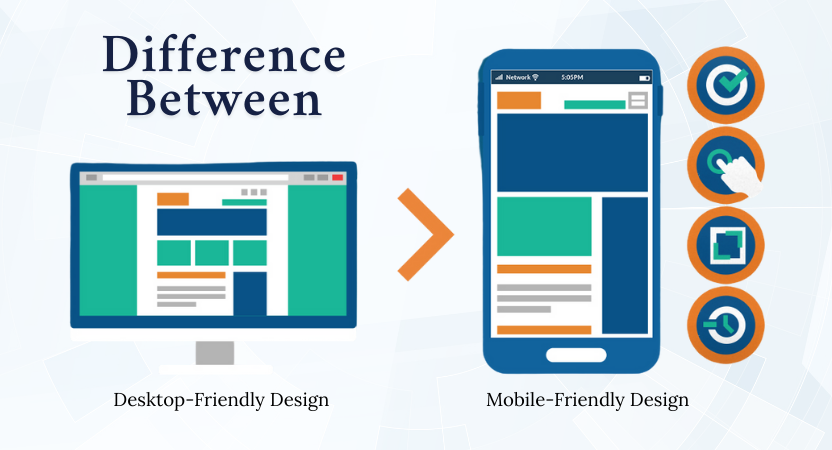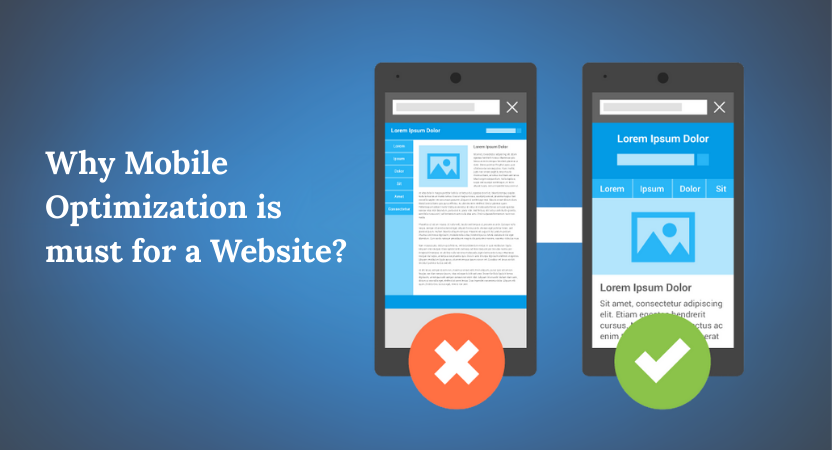Having a mobile-friendly website is no longer optional; it’s essential in today’s digital age. According to Forbes magazine, more than 75% of users have shifted from desktop to mobile devices. The business must prioritise delivering a seamless mobile experience to stay competitive and improve search engine rankings.
A mobile-friendly website helps to enhance the user experience by improving search engine performance, conversion rates, and overall customer satisfaction. This blog will help you understand the key elements of a mobile-friendly website, the differences between a desktop and mobile-friendly website design, and how you can implement mobile-first design strategies to boost a website’s performance and its SEO.
What is a mobile-friendly website?
A mobile-friendly website is better designed and optimised and functions well on smaller screens, such as tablets and smartphones. This optimisation ensures that the content is easy to read with smooth navigation and fast loading speed to offer the best user experience.
Mobile-first indexing is now the top priority for search engines like Google. Businesses need to adopt responsive and fast-loading designs to rank higher and attract more traffic. A mobile-friendly website should adjust to different screen sizes, load quickly, and maintain functional design elements without compromising the user experience.
Difference Between a Mobile-Friendly and a Desktop-Friendly Website

So many businesses create desktop-friendly websites first and then adapt them to mobile-friendly websites. However, this has been observed that following this process leads to slow loading speeds and a poor user experience on mobile devices.
Let’s understand the difference between mobile and desktop-friendly websites for effective optimization.
| Feature | Desktop-Friendly Website | Mobile-Friendly Website |
| Design Approach | Designed especially for laptop screens | Designed for smaller screens, like tablets and smartphones. |
| Navigation | Multiple menus and options are available for navigation. | Simplified navigation with easy-to-click buttons available. |
| Loading speed | Tolerable at 3-5 seconds | Should load within 2 seconds for better performance. |
| Font and Text | Larger text with more space. | Readable font size, optimized for smaller screens. |
| Media and Images | High-resolution images and media. | Compressed fast-loading images and videos |
| Form | Multiple fields and detailed forms. | Sorter, simplified forms for easy submission. |
| SEO Priority | Desktop-first indexing | Mobile-first indexing with responsive designs. |
Why is a Mobile-Friendly Website Important?
- Mobile-First Indexing by Google
The default method used by Google for ranking websites is mobile-first indexing. This means that Google first crawls and indexes the mobile version of any website rather than the desktop version. If your site is not mobile-friendly, your website rankings and traffic could suffer.
- Higher User Engagement and Lower Bounce Rates
Every mobile user expects quick access to information. If your website takes too long to load or is difficult to navigate, users are more likely to leave, which will ultimately lead to an increase in bounce rates and will reduce conversions.
- Increased Conversions and Sales
A website that is fast and easy to navigate usually encourages users to complete actions such as signing up, making a purchase, or filling out a form. Optimising mobile forms and ensuring a streamlined checkout process can boost conversion rates significantly.
- Competitive Edge
Most business owners focus firstly on making a website friendly for desktop but fail to adapt it to mobile friendly, and that puts the business at a major disadvantage. A mobile-friendly website helps you to stand out in search results and provides a better user experience with top search rankings.
Best Practices for Optimizing Your Website for Mobile
1. Mobile-First Design Strategies
Opting for a mobile-first design approach for creating the website for mobile devices first, and then scaling up for desktop is the best approach. This ensures that the mobile experience is prioritised from the start and hence helps Google crawlers to crawl and rank easily.
- Design with thumb-friendly navigation
- Using a single-column layout for easy scrolling.
- To focus on essential content and eliminate complicated content.
2. Responsive Web Design Techniques
Responsive design allows the website to automatically adjust to different screen sizes and orientations. This ensures that the website looks good and functions properly on any device, like tablets, smartphones, or desktops.
- To use CSS media queries to define various screen sizes.
- To maintain consistent fonts, colours, and layouts.
- Testing across different devices to ensure the responsiveness of the website.
3. Mobile Site Speed Optimization
Page loading speed is important for mobile users. Slow loading times lead to higher bounce rates and lost conversions.
- Compressing images and videos
- Minimizing HTTP requests
- Using lazy loading for images and media
- Enabling browser caching and reducing server response time
4. Font and Text Optimization
Ensuring that the text is readable without zooming or scrolling horizontally is important.
- Using a minimum font size of 16px
- Keeping line height and spacing consistent
- Avoiding decorative fonts that are hard to read on small screens
5. Optimize Mobile Forms for Better Conversions
Forms should be easy to complete on a touchscreen device.
- Using larger input fields and buttons is crucial.
- Enabling auto-fill for convenience will enhance form-filling numbers.
- Minimizing the number of required fields is also important.
- Providing real-time validation to reduce errors.
6. Meta Description Tips for Mobile SEO
A well-crafted meta description improves a website’s visibility in search engine results.
- Keeping meta descriptions under 155 characters enhances the chance of visibility.
- Include relevant keywords like mobile-friendly website
- Make it compelling to increase click-through rates
7. Schema Markup for Mobile SEO
Schema markup helps search engines understand website content better and display rich snippets in search results.
- Adding local business schema for location-based searches
- Using product schema for eCommerce sites enhances the website’s visibility.
- Including FAQs schema to answer common user questions.
8. How to Test Website Performance
Regular testing helps to identify and fix issues that affect mobile performance.
- Using Google’s Mobile-Friendly Test tool.
- Checking page speed using Google PageSpeed Insights.
- Testing on real devices to ensure consistent performance.
Best Practices for Optimizing Your Website for Mobile
1. Mobile-First Design Strategies
Opting for a mobile-first design approach for creating the website for mobile devices first, and then scaling up for desktop is the best approach. This ensures that the mobile experience is prioritised from the start and hence helps Google crawlers to crawl and rank easily.
- Design with thumb-friendly navigation
- Using a single-column layout for easy scrolling.
- To focus on essential content and eliminate complicated content.
2. Responsive Web Design Techniques
Responsive design allows the website to automatically adjust to different screen sizes and orientations. This ensures that the website looks good and functions properly on any device, like tablets, smartphones, or desktops.
- To use CSS media queries to define various screen sizes.
- To maintain consistent fonts, colours, and layouts.
- Testing across different devices to ensure the responsiveness of the website.
3. Mobile Site Speed Optimization
Page loading speed is important for mobile users. Slow loading times lead to higher bounce rates and lost conversions.
- Compressing images and videos
- Minimizing HTTP requests
- Using lazy loading for images and media
- Enabling browser caching and reducing server response time
4. Font and Text Optimization
Ensuring that the text is readable without zooming or scrolling horizontally is important.
- Using a minimum font size of 16px
- Keeping line height and spacing consistent
- Avoiding decorative fonts that are hard to read on small screens
5. Optimize Mobile Forms for Better Conversions
Forms should be easy to complete on a touchscreen device.
- Using larger input fields and buttons is crucial.
- Enabling auto-fill for convenience will enhance form-filling numbers.
- Minimizing the number of required fields is also important.
- Providing real-time validation to reduce errors.
6. Meta Description Tips for Mobile SEO
A well-crafted meta description improves a website’s visibility in search engine results.
- Keeping meta descriptions under 155 characters enhances the chance of visibility.
- Include relevant keywords like mobile-friendly website
- Make it compelling to increase click-through rates
7. Schema Markup for Mobile SEO
Schema markup helps search engines understand website content better and display rich snippets in search results.
- Adding local business schema for location-based searches
- Using product schema for eCommerce sites enhances the website’s visibility.
- Including FAQs schema to answer common user questions.
8. How to Test Website Performance
Regular testing helps to identify and fix issues that affect mobile performance.
- Using Google’s Mobile-Friendly Test tool.
- Checking page speed using Google PageSpeed Insights.
Mobile-Friendly Website Design Checklist
- Responsive design using CSS media queries
- Fast loading speeds (under 2 seconds)
- Compressed images and media
- Easy-to-read fonts and simple navigation
- Mobile-first design approach
- Optimized meta descriptions and schema markup
- Streamlined and user-friendly forms
- Regular performance testing and updates
Learn Mobile Optimization from the Best: Digital CourseAI

If you want to master the art of creating mobile-friendly websites and grow your career in web design or SEO, Digital CourseAI is the best place to learn. Their expert-led courses cover:
- Mobile-first design strategies
- Mobile site speed optimization
- Schema markup and structured data
- SEO techniques for mobile and desktop
- Real-world projects and hands-on experience
Digital CourseAI offers a structured curriculum designed to equip you with the latest tools and techniques to create high-performance websites. Whether you’re a beginner or an experienced developer, Digital CourseAI will help you take your skills to the next level.
Conclusion
Creating a mobile-friendly website is no longer just an option—it’s a necessity in today’s mobile-dominated world. By adopting a mobile-first design strategy, optimizing loading speeds, and enhancing the user experience, you can improve your search engine rankings and boost conversions.To stay ahead of the competition and deliver top-tier user experiences, consider learning from the best at Digital CourseAI. A well-designed mobile-friendly website will not only enhance user satisfaction but also contribute to long-term business growth.

